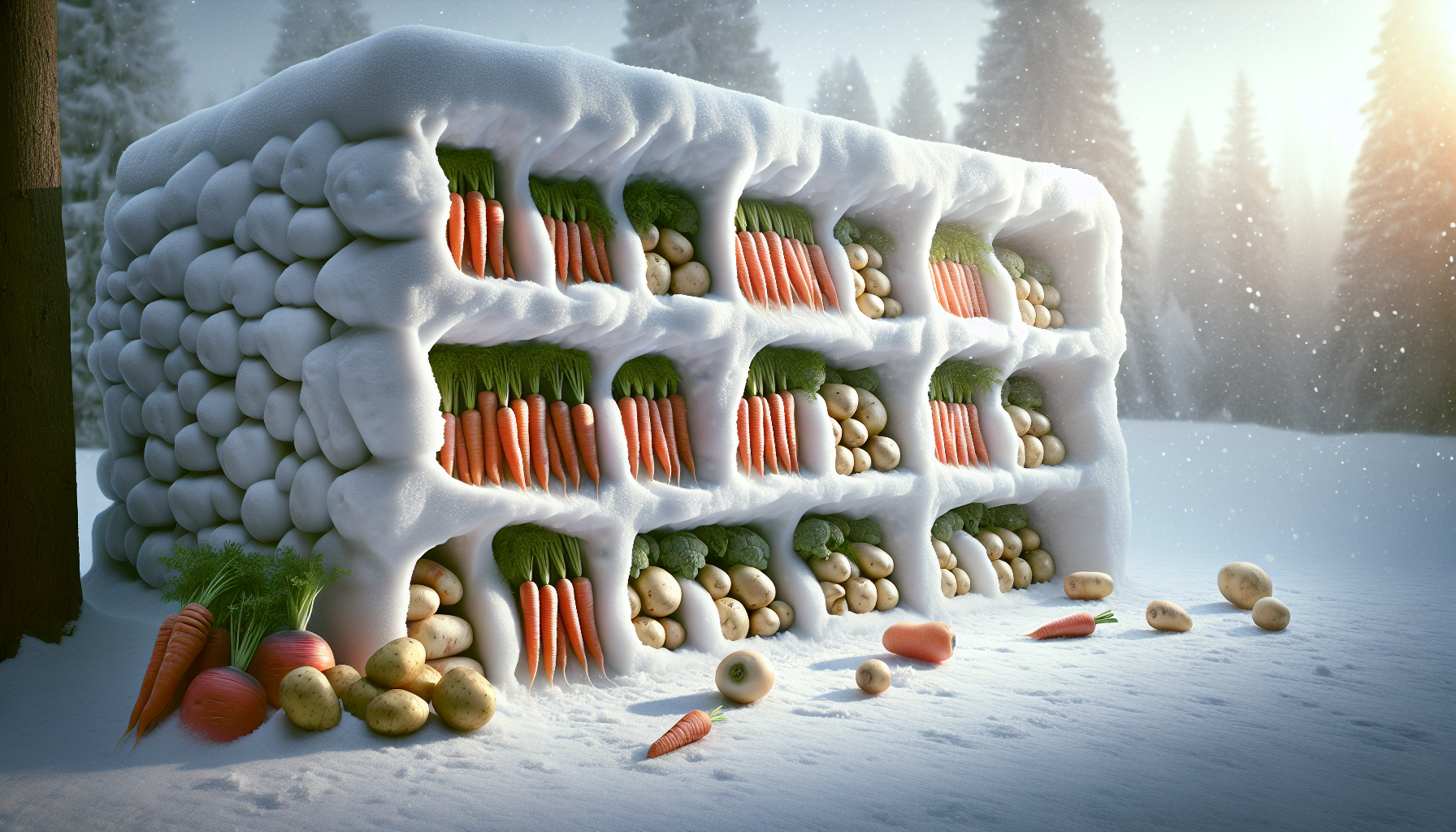In a world where fresh produce often comes at a premium, particularly during the colder months, the quest for effective and sustainable storage solutions has never been more crucial. Imagine being able to enjoy garden-fresh vegetables and crisp fruits throughout the winter, without relying on the costly and often environmentally taxing options available at the grocery store. Enter the age-old yet revolutionary technique of snowbank root storage—a method that might just be the ultimate solution for preserving the freshness and flavor of your produce all winter long. ❄️
For centuries, before the advent of modern refrigeration, communities in colder climates ingeniously used the natural insulating properties of snow to store their harvest. This technique, often overshadowed by more contemporary methods, is making a well-deserved comeback. Not only does it offer a cost-effective way to keep your produce fresh, but it also aligns seamlessly with sustainable living practices. In this article, we’ll delve into the fascinating world of snowbank root storage, unraveling its secrets and exploring how you can incorporate this method into your lifestyle.
At its core, snowbank root storage leverages the insulating power of snow to maintain a stable, cool environment, perfect for preserving the integrity of various fruits and vegetables. From the science behind how this works to the practical steps needed to implement your own snowbank storage, we will cover it all. You will learn which types of produce are best suited for this method and how to prepare them for optimal storage. Whether you have a sprawling backyard or a modest garden, you’ll discover how to harness the winter’s chill to your advantage.
But why stop at the technical details? We’ll also explore the broader benefits of adopting snowbank root storage. Beyond the immediate advantage of keeping your produce fresh, this technique supports a more sustainable way of living. By reducing reliance on artificial refrigeration and cutting down on food waste, snowbank storage helps decrease your carbon footprint. Moreover, it offers an opportunity to reconnect with nature’s rhythms and embrace a slower, more intentional way of life—one that respects the seasons and the bounty they offer. 🌿
Understanding the Concept of Snowbank Root Storage
Snowbank root storage is an age-old technique that utilizes the natural insulation properties of snow to store root vegetables, keeping them fresh throughout the winter months. This method is deeply rooted in traditional practices but remains highly effective and relevant in today’s eco-conscious environment. By leveraging the insulating properties of snow, this storage technique maintains a consistent temperature around the produce, preventing freezing while also slowing down spoilage processes. This section will delve into how snowbank root storage works and why it is still considered one of the ultimate solutions for winter produce preservation.
The principle behind snowbank root storage is relatively simple: it takes advantage of the snow’s ability to maintain a steady, low temperature around the stored produce. When roots such as potatoes, carrots, and beets are buried under a thick layer of snow, the snow acts as a natural barrier against extreme cold and wind, preserving the freshness and nutritional value of the vegetables. This storage method is particularly useful in regions that experience heavy snowfall, where the snow can provide ample insulation for several months.
Another significant advantage of snowbank root storage is its sustainability. Unlike modern refrigeration methods that require electricity and contribute to carbon emissions, snowbank storage relies entirely on natural resources. This eco-friendly aspect makes it an attractive option for individuals looking to reduce their environmental footprint. Furthermore, by using locally available resources such as snow and soil, this technique promotes self-sufficiency and reduces dependency on external resources.
The Mechanics of Snowbank Root Storage
The process of setting up a snowbank root storage system is straightforward but requires careful planning and execution. The first step involves selecting an appropriate location. Ideally, this should be a well-drained area where snow accumulation is natural and consistent. Once the location is chosen, a pit is dug into the ground deep enough to accommodate the intended quantity of produce. The depth of the pit can vary depending on the type of vegetables and the expected snowfall.
After preparing the pit, the produce is carefully arranged in layers, with each layer separated by a covering of straw or hay. This organic material provides additional insulation and helps regulate humidity levels within the pit. Once the produce is arranged, the pit is covered with a thick layer of snow, which acts as the primary insulating material. Throughout the winter, it is important to monitor the snowbank and add more snow if necessary to maintain adequate insulation.
Benefits of Snowbank Root Storage
The advantages of using snowbank root storage extend beyond its simplicity and sustainability. One of the primary benefits is the ability to maintain the flavor and nutritional value of the produce. Unlike refrigerated storage, which can cause vegetables to lose moisture and taste over time, snowbank storage preserves the natural moisture content and flavor of the produce. This is particularly important for root vegetables, which can become dry and lose their sweetness when stored improperly.
Moreover, snowbank root storage is a cost-effective solution. By eliminating the need for electricity and expensive refrigeration equipment, individuals can save money while still ensuring their produce remains fresh throughout the winter. This is especially beneficial for small-scale farmers and gardeners who may not have access to modern storage facilities. By utilizing natural resources, they can effectively extend the shelf life of their harvest without incurring additional costs.
Additionally, snowbank root storage supports local food systems by encouraging the consumption of seasonal and locally grown produce. By storing vegetables using this method, individuals can enjoy fresh, homegrown produce even during the harsh winter months. This not only supports local agriculture but also reduces the carbon footprint associated with transporting out-of-season produce from distant locations.
Potential Challenges and Solutions
While snowbank root storage offers numerous benefits, there are potential challenges that individuals may encounter when implementing this method. One common issue is the risk of rodents and other pests accessing the stored produce. To mitigate this risk, it is essential to take preventive measures such as lining the pit with a mesh or wire barrier and covering the snowbank with a layer of soil or mulch. These barriers can deter pests while still allowing the snow to provide adequate insulation.
Another challenge is the variability in weather conditions. In some regions, unpredictable weather patterns may lead to inadequate snowfall, compromising the effectiveness of the storage method. In such cases, individuals can supplement the snow with additional insulating materials such as straw bales or blankets to ensure the produce remains protected. It is also important to monitor the pit regularly to check for signs of melting or moisture buildup, which can lead to spoilage.
Comparing Snowbank Root Storage with Modern Alternatives
To fully appreciate the value of snowbank root storage, it is helpful to compare it with modern alternatives. While refrigeration and controlled-atmosphere storage are popular options, they come with their own set of advantages and disadvantages.
| Storage Method | Advantages | Disadvantages |
|---|---|---|
| Snowbank Root Storage |
|
|
| Refrigeration |
|
|
| Controlled Atmosphere Storage |
|
|
As illustrated in the table, snowbank root storage offers unique benefits that are not matched by modern methods. Its eco-friendly nature and ability to maintain the natural qualities of produce make it a valuable option for those seeking sustainable storage solutions.
Watch and Learn
For a visual understanding of snowbank root storage, consider watching the video below, which provides a step-by-step guide on setting up a snowbank storage system in your own backyard. This practical demonstration highlights the ease and efficiency of this method, offering valuable insights for beginners and seasoned gardeners alike.
Snowbank Root Storage: A Step-by-Step Guide – GreenThumbs Channel

Conclusion
Unleashing the power of snowbank root storage is a game-changer for anyone looking to keep produce fresh all winter long. Throughout this article, we explored the historical significance, practical applications, and modern innovations surrounding this age-old method of preservation. From the traditional practices of our ancestors to today’s environmentally conscious and resource-efficient adaptations, snowbank root storage offers a sustainable and effective solution for food preservation.
To recap, we began by examining the historical roots of this practice, highlighting how communities across various cultures have utilized snow and cold storage to prolong the life of their harvests. This method, deeply ingrained in human history, not only helped in surviving harsh winters but also played a crucial role in food security and reducing waste.
We then transitioned to the practical aspects of snowbank root storage. By understanding the ideal conditions—such as temperature, humidity, and ventilation—we can effectively recreate these environments to preserve produce. Key techniques, such as proper layering and insulation, were discussed to maximize the longevity and quality of stored goods. The emphasis on using natural and locally available materials makes this method not only accessible but also eco-friendly.
Modern innovations have breathed new life into snowbank root storage. Today, we see a blend of traditional knowledge with contemporary technology, such as temperature sensors and humidity controls, which ensure optimal storage conditions. These advancements have made it possible for even those in urban environments to utilize snowbank storage, emphasizing its relevance in today’s world.
The importance of adopting such sustainable practices cannot be overstated. In a world where food waste is a growing concern and climate change impacts are felt globally, methods like snowbank root storage present viable solutions to some of these pressing issues. By reducing waste and energy consumption, we contribute to a healthier planet and a more sustainable future.
Furthermore, engaging with snowbank root storage can foster a deeper connection with our food sources. It encourages mindfulness about what we consume and how we preserve it, fostering a greater appreciation for the natural cycles and the work that goes into producing our food. This practice also supports local agriculture by providing a reliable method for farmers to store their produce, potentially increasing their revenue and reducing losses.
As we conclude, I invite you to explore the potential of snowbank root storage in your own life. Whether you are a farmer, a home gardener, or someone interested in sustainable living, this method offers a unique opportunity to engage with food preservation in a meaningful way. 🌿
Consider implementing some of the techniques discussed in this article or collaborating with local community groups to share resources and knowledge. Sharing your experiences and insights can inspire others and create a ripple effect of positive change. 💬
I encourage you to comment below with your thoughts or experiences regarding snowbank root storage. Have you tried it? What challenges or successes have you encountered? Your input is invaluable in fostering a community of learning and sustainability.
Share this article with others who might be interested in sustainable food practices or those who might benefit from a reliable preservation method. Together, we can promote a more sustainable and conscious way of living.
For further reading and exploration of this topic, you can visit reliable sources such as the and Food and Agriculture Organization of the United Nations which provide valuable insights into sustainable agricultural practices and food preservation techniques.
In closing, remember that every small action towards sustainability counts. By embracing the power of snowbank root storage, you are contributing to a larger movement towards a more resilient and environmentally-friendly world. Let’s keep the conversation going and continue to explore innovative ways to live in harmony with our planet. 🌎





